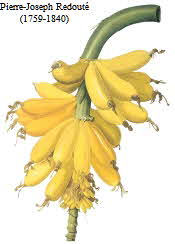Home | FOOD ARTICLES | Food Trivia | Today_in_Food_History | Food_History_Timeline | Recipes | Cooking_Tips | Food_Videos | Food_Quotes | Who’s_Who | Culinary_Schools_&_Tours | Food_Trivia_Quizzes | Food_Poems | Free_Magazines | Food_Festivals_and_Events
Food Articles, News & Features Section
FREE Magazines
and other Publications
Free Professional and Technical Research, White Papers, Case Studies, Magazines, and eBooks
See also: Bananas, 3rd Most Popular Fruit; Banana Facts;
Banana Trivia; Banana Bread
Going Bananas
FOOD FOR THOUGHT - October 3, 2007 - Mark R. Vogel - Epicure1@optonline.net - Mark’s Archive
Recipe below
The banana tree originated in India and eventually found its way through the tropical regions of the world, namely, Africa, Latin America, Australia and Southeast Asia. If you want to get technical however, the banana is not a tree. The “tree” is actually a large herb and the banana is botanically speaking, a berry.
Switching from scientific technicalities to the mystical, an early Indian version of Adam and Eve asserts that the banana, not the apple, was the original forbidden fruit. Upon being banished from Eden, Adam and Eve supposedly covered themselves in banana leaves.
Returning to the tangible universe, each banana tree produces one and only one bunch of 100-400 bananas in its life. The groups of bananas are called hands and the individuals are referred to as fingers. Indeed, the name banana derives from the Arabic word “banan” meaning finger. Bananas were brought to Europe from Africa by the Portuguese and were well established there by the 18th century. India is the world’s largest producer but the banana is an important food crop all over the world. There are hundreds of species of banana but by far the most common is the Yellow Cavendish, which you can find in any American supermarket.

Bananas taste best when ripened off the tree. They are usually shipped green to extend their transportation and shelf life. As they ripen they become speckled with dark brown spots. Smaller bananas tend to be sweeter than their big brothers. Generally it is best to leave them out of the refrigerator. They can be refrigerated but their skin turns dark brown to black. To hasten their ripening, place them in a paper bag. In fact, if you’d like to speed up the ripening of your avocados, add them to the bag of bananas. Bananas, (and apples), give off ethylene gas, a ripening agent. Once cut open, like many other fruits, bananas turn brown with prolonged contact to air. Depending on your recipe you may need to mix your exposed bananas with lemon juice. Bananas are high in potassium and vitamin C but also contain vitamins A and B6. Choose bananas that are free of blemishes and soft spots.
Bananas can be cooked in many different ways such as poaching, grilling, sautéing, and flambéing such as in the New Orleans classic Bananas Foster. Bananas are most often employed as a dessert or in baked goods. They can utilized to make ice cream, pies, fruit salads, soufflés, muffins, flans, fritters, bread, and pancakes, as in the recipe below. Banana leaves are common in Latin American cooking and used to wrap different kinds of food. There is even banana flour, made from dried and ground bananas.
Plantains are a variety of banana and indispensable to the cuisines of Latin America and Africa. They are starchier, less sweet, and more firmly textured than traditional bananas. Because of these qualities they are treated more like potatoes than a sweet fruit. Plantains do not peel as easily as bananas and must be cut to release their skin. They can be baked, boiled, sautéed, or grilled. One of the simplest and best ways to enjoy plantains is to sauté them in butter. Slice a few plantains and sauté them in an ample amount of butter until browned on each side. Add salt or sugar depending on whether you’d like a sweet or savory outcome. Serve them as a side dish with your Latin American fare.
RECIPE:
BANANA PANCAKES

INGREDIENTS:
• 4 oz. flour
• 1/3 teaspoon of salt
• 1 ½ oz. sugar
• ½ teaspoon baking soda
• 1 teaspoon baking powder
• 2 large fully ripe bananas, mashed
• 6 oz. milk
• 1 egg
• ½ oz. melted butter
DIRECTIONS:
Combine the dry ingredients and sift them. Use a flour sifter or if you don’t have one, pour the dry ingredients into a handheld fine sieve and tap them through it into a bowl.
In a separate bowl add the mashed bananas and all of the remaining wet ingredients. Whisk the wet ingredients thoroughly to ensure uniform incorporation of the bananas.
Add the wet ingredients to the dry and mix. They do not have to be perfectly mixed; some lumps are OK and will cook out.
Heat a large skillet or electric griddle, (for the latter I set it to 350 degrees), and grease with butter or cooking spray.
Dollop spoonfuls of the batter onto the griddle.
Flip when bubbles start to appear and/or the edges begin to set.
The second side will only require brief cooking.
Top with lots of butter, your favorite syrup, and enjoy.
RELATED ARTICLES
Please feel free to link to any pages of FoodReference.com from your website.
For permission to use any of this content please E-mail: james@foodreference.com
All contents are copyright © 1990 - 2025 James T. Ehler and www.FoodReference.com unless otherwise noted. All rights reserved.
You may copy and use portions of this website for non-commercial, personal use only.
Any other use of these materials without prior written authorization is not very nice and violates the copyright.
Please take the time to request permission.

